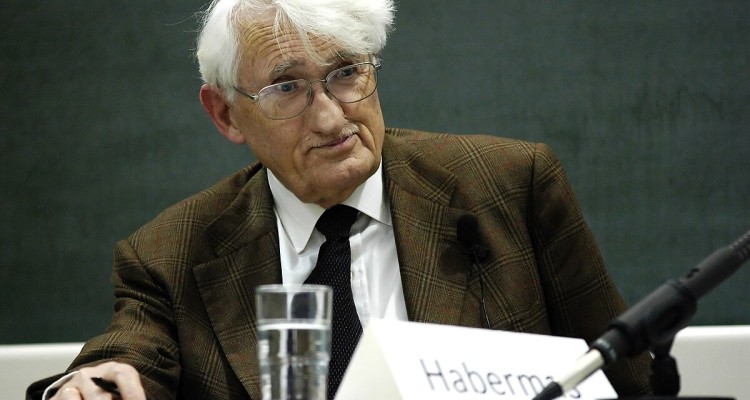Some reflections based on a recent publication
This text was written in a different context from that which emerged after October 7. It did, however, anticipate a double question precipitated by this event: that of the specificity of antisemitism within the logic of racism, and that of what, in contemporary societies, makes the potential victims of racism sometimes bearers, paradoxically, of antisemitic arguments.

“Race et histoire dans les sociétés occidentales (XVe-XVIIIe siècle)” [Race and History in Western Societies (15th-18th centuries] is one of the most influential works of its kind. As the authors, Jean-Frédéric Schaub and Silvia Sebastiani, recently pointed out in an interview with K., the book establishes a very different chronology from the one we are used to for the emergence of the phenomenon known as racism: it was not born in the 19th century but, as the authors show, four centuries earlier. The application of the notion of “race” to human beings, which can be observed from the time of the Renaissance, had no other use than a political one. From the outset, therefore, it implied not only racialization, but also racism. By establishing that the first thoughts on race were political, it leads us to redefine the phenomenon of racism in itself, from its origins in European history, and as it has continued down to the present day. We are thus encouraged to pay attention to the development that such a phenomenon has undergone even beyond the period studied by the authors, and to consider the way in which the manifestations of racism have evolved to become those we know today.
Our commentary here proceeds from this intention. Firstly, on reading the book, we would like to propose a definition of racism which, although not formulated by the authors, seems to us to be deducible from their analyses. In our view, this general definition leads to a fundamental distinction between two generative patterns of racism, which the book sets out but, in our view, does not sufficiently distinguish one from the other: while aristocratic racism is the matrix of the first, anti-Judaism is the model for the second. Then, as an extension of the book, we would like to try to reconstruct the fate of the two patterns thus distinguished after the moment at whose threshold the book leaves us, the end of the eighteenth century, which saw the advent of political modernity. If we are to bridge the gap between Schaub’s and Sebastiani’s reflections and the present day, it is vital to take account of developments over the last two centuries: While a direct leap between the two would lead us to formulate an erroneous diagnosis of the present, reconstructing the missing link allows us to make the best use of the work’s contributions to understand—as we shall endeavor to do in the final part of our paper—the contemporary motivations of racism and anti-Semitism, and to reflect on the way to combat them, adapted to the challenges of our time.
On Reading the Book
Racism on the part of aristocrats of ancient lineage towards those recently ennobled, racism on the part of Christians towards Judeo-Converts or, in American societies, racism on the part of white settlers towards mulattoes: by emphasizing the rejection provoked by ‘hybrid’ figures and, more importantly, by showing its centrality in the genesis of racist feelings, the book introduces us to a new vision. The binary opposition between one group that produces racism and another that experiences it, to which we are spontaneously attached, is here complexified into a ternary structure, in which it is the existence of hybridization already underway between the two groups, and the prospect, from then on, of seeing them mix even more, that motivates the desire, within the one of the two that dominates, to stop the previous positions, by racializing them. In this way, racism does not arise from the gap between a dominant and a dominated group. On the contrary, it arises from the narrowing of this gap, as the dominant group perceives this narrowing as a threat to itself and, more broadly, to society. This is the central, and in many ways revolutionary, thesis of the book.
By following the perspective it opens up, it seems possible to propose a general definition of the phenomenon of racism: it is the naturalization of the inability of a given group to adopt standards deemed superior to its own. In this sense, the notion of race does not primarily refer to considerations of a biological nature, but rather to a social operation of naturalizing a ‘defect’ that has been manifested and repeated in practice, namely a certain difficulty in acting and judging according to standards deemed superior. This incapacity may be understood by contemporaries as the effect of a physical and intellectual impossibility that is hereditarily transmitted—as in the case of the nobleman of commoner origin or the half-breed, judged by virtue of their blood to be incapable of acting and judging in the manner of a true nobleman or a true white man. Sometimes, too, incapacity is seen as resulting from a curse that is declared impossible to ward off, because it too is transmitted by blood—as in the case, as we shall return to, of converse Jews who fail to sincerely accept Christian salvation.

Retaining this definition leads us to distinguish between two patterns of engendering racist attitudes, the difference between which is not noted by Schaub and Sebastiani, but which their work leads us to observe.
In the first of these approaches, the naturalization of disability is the work of socially dominant groups anxious to curb access to the higher status that groups below them might enjoy. Formulated in this way, however, the analysis remains solely at the level of strategic action. To adopt a more fully sociological point of view—the one Max Weber called ‘comprehensive’—we should add that members of dominant groups find themselves morally shocked by the inability of members of socially inferior groups to respect the standards of behavior which, in their view, go hand in hand with higher status. What they naturalize, then, is first and foremost the naturalness and spontaneity with which they themselves respect the norms associated with higher status. It is also, secondly, the inability regularly demonstrated by members of socially inferior groups to respect them, or at least to respect them as naturally and spontaneously as they do. Thus, at the root of this naturalization of the capacities of “us” and the incapacities of “them” lies a certain type of observation based on experience. The nobility distinction with regard to newly ennobled persons, examined in the first chapter of the book, is the first and matrix manifestation of this type of racism brought about by a certain equalization of conditions. But it can also be associated, for example, with the racism against blacks that developed at the end of the nineteenth century in the southern United States, following the abolition of slavery. In a way, it should also be associated with what Pierre Bourdieu, in La distinction, called “class racism.” For in fact, this first schema corresponds to a racism which, however biologising it may appear, can ultimately be interpreted on the basis of the relations of domination which prevail between social strata or classes. More precisely, it can be understood as a reaction on the part of dominant groups to the ongoing narrowing of the social gaps between these strata or classes.
In the second approach, the naturalization of incapacity finds its starting point in the ambition of the proponents of one religion, Christianity, to universally convert those who do not yet identify with it. In this second scheme, unlike the first, it is no longer a question of curbing access to a status considered enviable: on the contrary, it is a question of generalizing it for all, and accelerating it. From then on, the central phenomenon to be taken into account is the “obstinacy” of non-Christians to remain what they are, and to persist in wanting to form, within societies dominated by Christianity, religious groups that are resolutely “below” Christian norms. It is this obstinacy that leads not only to disappointment among Christians but also, and above all, to hostility among the most impatient of them, insofar as the persistence of non-Christians in rejecting the revelations of the Christian religion makes them an obstacle to the salvation of the whole of humanity.
Racism in this scheme occurs when Christians, renouncing their desire to convert universally, undertake to naturalize the inability of certain non-Christian groups and their future descendants to convert to the Christian faith. Here again, racist naturalization refers to a form of experience, and in this respect it does not appear to be devoid of a practical basis. Certain non-Christian religious groups can indeed demonstrate their desire to persist in their own being, and thus regularly give a sign of their indifference to the Christian message addressed to them, or even of their open refusal to recognize its logical and moral superiority. The fact remains, however, that this naturalization, because it leads to a renunciation of the ambition of universal evangelization which is at the foundation of the Christian religion, is always liable to be contested in the very name of Christian doctrine, and consequently to give rise to an internal debate within Christianity. The racialization of converse Jews provides the matrix for this racism, which arose from the limitations of Christian evangelization. But it can also be associated, for example, with certain aspects of racism towards the Amerindian peoples who were forcibly converted and continued to cultivate their pagan beliefs in secret.
If this second approach deserves to be distinguished from the first, it is because the racism that corresponds to it is not essentially based on relations of social domination—although it may combine with them. Its foundation lies much more in a religious desire to equalize conditions—which, in the Christian societies of the Ancien Régime, we should note, is aimed only at the spiritual level. More precisely, this second type of racism can be interpreted as a reaction to the obstinacy of certain non-Christians to remain such, and to persist as a non-Christian religious group, this obstinacy and this persistence being perceived as obstructing the fulfillment of the religious will for universal equalization on the spiritual level.

In both cases, racism proceeds by naturalizing an inability, and in each case has a fundamentally reactionary aspect. But whereas in the first approach, that of class racism, it is a reactionary attitude provoked by a certain objective equalization of conditions, in the second, that of Christian racism, the reactionary attitude is provoked by a certain disappointed expectation of equalization of conditions. In analyses of contemporary racism, the emphasis is mainly on the first approach, and there are good reasons for this. But the racism of Christians is no less important, because it reminds us that racist behavior, as a reactionary attitude, can also be generated within movements initially favorable to a greater equalization of conditions. Anticipating what we are going to develop in the lines that follow, we can think in this respect of the extreme right-wing political movements, from the moment when, at the end of the nineteenth century, they rallied to the national idea. But we must also think, of course, of socialist movements. And even certain liberal thinkers, to the extent that they too are aiming for greater equality of conditions, even if only in terms of formal law.
Extending the Publication
Schaub and Sebastiani’s book ends its course on the steps of political modernity. It therefore leaves us with the question of how, from the end of the eighteenth century onwards, the advent of the ‘nation’ form and the development of state apparatuses placed at its service affected the two patterns we have just distinguished. Answering this question is crucial if we are to make an accurate diagnosis of the various forms of racism that are manifest in our time.
First of all, as far as class racism is concerned, we have to admit that the advent of political modernity has extended and generalized its practice. Far from the aristocracy retaining a monopoly on it in relation to commoner families, this specific type of tendency to naturalize disabilities has spread to the various strata of society, as the division of labor and social mobility have increased. At the end of the nineteenth century, certain sections of the upper middle class adopted this approach in their dealings with the ‘new rich’ and entrepreneurs from less economically developed countries, whose inability to master the ‘right’ codes could then be attributed to their heredity. The same mechanism was reproduced with the petty bourgeoisie and the working-class elite in their relations with their new members from poor countries, the world of migrants and the sub-proletariat. In some quarters, the bourgeoisie, then the petty bourgeoisie, originally broadly inclined towards liberalism, and eventually even part of the working class, sometimes inclined until then towards socialism, developed a reactionary and racist way of thinking, as the classes immediately below them drew closer to them socially and mingled with them. The result was that individuals who were victims of social racism on the part of the classes above them were now able to produce such racism themselves in relation to the classes below them. Here again, as in Schaub and Sebastiani’s description of the dynamics of this pattern in earlier centuries, the extension of class racism was brought about by increased social mobility and a narrowing of the gap between social classes. Two major egalitarian movements appear to have fueled this process: on the one hand, in the nineteenth century, the abolition of slavery in the nations of Europe and North America; on the other hand, in the twentieth century, in these same nations, the development of the welfare state and social assistance. In this respect, the fact that society as a whole, and not just aristocratic circles, is prey to class racism should be seen as the mark of a progression towards the objective equalization of conditions within it—even if this is a reactionary effect, and therefore a retrograde political will, in the face of this progression.
Secondly, with regard to the egalitarian racism of Christians, it is important to take into account the effects that the birth of modern nations has had on Christian universalism and individualism, namely that it has secularized and nationalized them, without, however, undoing—quite the contrary—the theological-political matrix that they provided. It was in the course of this process that the definitive shift took place from traditional anti-Judaism, based on overtly religious motives, to modern anti-Semitism, based on nationalist motives.
From the nineteenth century onwards, it was nationalism itself, without any explicit link to the Christian religion, that became the main vehicle for denouncing Jewish “obstinacy” throughout Europe. The result was an ethnicisation, even a biologisation, of the Jews, in which the Jewish religion was relegated to the background as a mere epiphenomenon of the ‘race’. Certainly, for Maurras and for Catholic traditionalism, as in ‘holy’ Russia, Judaism remains what it was in the eyes of medieval anti-Judaism: a religious obstacle to the triumph of Christianity. But it is no longer so central, as the nationalist motive takes precedence everywhere. This secularization is particularly marked in Fascism and Nazism, for which the Jewish religion is no longer a problem in itself: It was rather what it was deemed to be the symptom of that was seen as the obstacle to be removed, namely the persistence, within the nation, of a Jewish “race” or even a Jewish “mentality”—in other words, the “obstinacy” of Jews, even when as individuals they had become citizens of the nation, to feel that they were in solidarity with a group other than the nation. It should be noted that since this solidarity between Jews is both presupposed and naturalized by anti-Semitism, it acquires an unfalsifiable character in its eyes, since no proof of their belonging to the nation, and of their sacrifice for it, can suffice to exonerate Jewish citizens from their “primary” belonging to the group formed by the Jews.
Egalitarian racism was thus profoundly reshaped by political modernity. The standards deemed superior, which the stigmatized group is deemed to be “naturally” or “definitely” incapable of adopting, are no longer those of Christian universalism and individualism but, from now on, those of national belonging. We feel it is important to make it clear that these norms of national belonging, which are considered superior, are not, despite appearances, the remnants of the holistic and hierarchical norms of the Ancien Régime. On the contrary, they are the expression of a form of individualism and egalitarianism of Christian origin which finds its expression in the modern nation, both secularized and ‘temporalised’—the latter term to be understood in the sense that the equalization of conditions in the nation is no longer aimed solely at the spiritual level but also, and primarily, as a real and temporal achievement. This remains true in the case of totalitarian regimes, where this egalitarian individualism is reinterpreted in reactionary and racist terms—in other words, in what Dumont calls a “monstrous” manner. Thus, even and especially in the case of such totalitarian regimes, we are justified in evoking an egalitarian-nationalist racism which, in modern politics, has taken over from the egalitarian-Christian racism of Ancien Régime societies.

The transformation of traditional Christian anti-Judaism into modern anti-Semitism is the key to understanding this. In fact, it was this specific type of racism which, in the 20th century, led to the persecution of the Jews by the Fascist regimes and founded the Nazi enterprise of their systematic destruction. It was this racism that led to the similar fate of gypsies and “stateless people” under these regimes. In the Soviet Union, it manifested itself in the tendency of political power to naturalize the inability of kulaks and “class enemies” and their descendants to convert to the Bolshevik cause, and then, with an ever more assertive nationalist mentality from the 1930s onwards, to suspect Jews and certain other nationalities within the Union of not being capable of being “fully” Soviet. At the beginning of the twentieth century, he also recognized himself in the genocide of the Armenians organized by the “Young Turks”, as he did at the end of the century in those perpetrated by the Khmer Rouge in Cambodia and by the Hutus in Rwanda. The cases that could be cited here are numerous. However, this extension of egalitarian racism with nationalist motives to the whole planet is not surprising. Its generalization is an effect of the growing integration of human groups into a **stato-national framework, and of what results from this: the growing internalization by citizens of individualistic and egalitarian norms. Thus, the more a society is plagued by egalitarian-nationalist racism, the more it should be seen as a sign of the progress of national state-building. But here again, we are talking about a reactionary attitude towards this construction, in which, on the part of certain individuals, the renunciation of certain community ties, or at least their subordination to the norms of national belonging, turns into a negative judgment of other individuals who, in their view, have not done so.
It is only in the light of the foregoing that it becomes possible, in our view, to address the question of modern colonialism as it relates to racism. By “modern colonialism,” we do not mean the colonialism examined by Schaub and Sebastiani, which concerns colonial and slave-owning societies in the Americas from the 16th to the 18th century, and whose links with racism they describe perfectly. We understand colonialism to have developed from the 19th century onwards, with the advent of nation states and political modernity in Europe.
From what we have seen, we understand that this kind of colonialism can obey two different logics: in some cases, it is openly racist, because its promoters see the colonized populations and their descendants as forever incapable of acquiring the superior standards of the colonizers. What’s more, they consider it undesirable for these populations to attempt such an acquisition. Such was the attitude of the colonizers, for example, in the colonies held in Africa by Germany (before the First World War), Belgium or Fascist Italy, or in the Far East by Japan, or in the Ukrainian and Russian territories occupied in 1941 by Nazi Germany. This was also the attitude adopted by the white authorities in South Africa until apartheid came to an end. In other cases, such as that of the British and French Empires in particular, colonialism claimed to be “civilizing,” not to say “emancipatory,” as it officially set itself the task of making the colonized populations acquire the standards deemed superior by the colonizers and thus enable them, at least in theory, to belong fully to the colonizing nation or to a community of nations (Commonwealth) equal in rights and dignity with the latter. This second type of colonialism is no less inclined than the first to assert what it regards as the indisputable superiority of the colonizing nation’s standards over those of the colonized peoples. Its distinctive feature, however, is that it denaturalizes the inability of the latter to appropriate and internalize such superior standards. As we know only too well, such a “civilizing” doctrine in itself in no way prevents the colonizers from demonstrating racism towards the colonized. But at least this racism can be criticized, both within the colonizing nation itself and by intellectuals from the peoples it has colonized, in a way that recalls the “emancipatory” horizon that the colonial enterprise had set itself, and which is thus supported by the egalitarian and individualistic norms of the nation. Criticism of colonial racism, if not denunciation of the colonial enterprise itself, thus becomes a central element in the reflexivity that the colonizing nation can demonstrate about its own ideal and its ability to honor it.
Racism and anti-Semitism in Present-day France
With the help of the diagram we have just outlined, it seems to us that the present situation can be illuminated in a new light. In conclusion, we’d like to try to do just that, by focusing on the French case.
Current racism against immigrant populations of the Muslim faith in Europe (and France in particular) can be understood as a combination of the two racisms whose evolution we have been following. Firstly, there is class racism on the part of part of the upper and middle social strata towards the poorest and least educated members of these populations. But there is also, and perhaps above all, an egalitarian racism with a nationalist motive on the part of certain components of the social classes as a whole towards what they see as the “obstinacy” of Muslims, even when as individuals they have become citizens of the nation, to feel themselves to be in solidarity with a group other than the nation.
In terms of the class racism that targets them, immigrant populations or populations of immigrant origin from poor countries (which is what most of the so-called “racialized” consist of) find themselves referred to their lack of mastery of the codes of behavior proper to the upper and middle classes, and all the more so when their members manage to rise socially. In this way, they tend to be recognized as having certain “incapacities” linked to their origins. But this attribution, it should be noted, does not yet constitute racism in the sense in which we have defined the term: this is only the case when such incapacities are naturalized, i.e., deemed inescapable due to what is then seen as their irresistible reproduction by the “culture of origin” transmitted in the family or—but this is a motive more rarely stated today—by heredity. From this perspective, the question of education takes center stage in political terms. For if national education is far from successful in preventing the reproduction of class differences, at least it limits the belief in their natural and eternal character. In this respect, its very existence—if not the results it sometimes achieves—tends to heighten collective reflexivity about the properly social origins of the incapacities attributed to members of the lower classes. As a result, the lower socio-professional position they occupy becomes a little less easy to think of as a fair reflection of their lesser objective aptitudes. Then, and above all, these lower aptitudes, because it has been shown that education can have an influence on them, become more difficult to naturalize.
But class-based racism is obviously far from being the only factor that sums up the situation faced by immigrant populations or those of immigrant origin in France today. In fact, when they are Muslim and intend to assume their faith, they are easily seen as active groups “against” the nation. The solidarity that unites Muslims can then come to be both presupposed and naturalized. This is particularly the case in the eyes of the most radical components of the far right, for whom this solidarity acquires an unfalsifiable status, since no proof of their belonging to the nation, and of their sacrifice for it, can suffice to exonerate citizens of the Muslim faith from their “primary” belonging to the group formed by Muslims. As a result, Muslim populations are the target of egalitarian-nationalist racism: they are seen as a “natural” obstacle to the achievement of the nation. This, incidentally, poses a fundamental problem for the Left: if racism against Muslims in French society were simply a matter of class racism, if it could easily and entirely be reduced to that, how much simpler and more comfortable things would be for the parties of the Left! But here’s the thing: it’s also, and in some cases first and foremost, egalitarian racism with a nationalist motive—which can only send the left back to its own aspirations as a political movement aiming to build nations where equality and individual autonomy prevail for all.

There are therefore three options open to left-wing thinking. 1) The first is to deny the existence of any particular solidarity between (some) Muslims: in this case, we give in to the liberal orientation, aligning ourselves with an abstract definition of individuals that subordinates the sociological understanding of their relationships to the legal understanding of their rights. The advantage of this approach is that it avoids the risk of demonstrating egalitarian-nationalist racism. But in diagnostic terms, it also means interpreting all racism of this kind as the expression of class racism, and thus obscuring the issues at stake in national construction in favor of those linked to social domination. The left, unwittingly espousing a liberal vision, comes to refuse to think about the nation and its emancipatory potential. 2) The second consists in naturalizing solidarity between Muslims, or at least between some of them, and castigating it as a danger to the nation and its egalitarian, individualist ideals. To do so is to run the risk—if, at the very least, this solidarity is not only observed but also naturalized—of joining reactionary thought and participating in the collective production of egalitarian-nationalist racism. 3) The third, finally, corresponds to the authentically socialist position. It consists (or would consist) in accepting the distinction between forms of community solidarity that do not oppress individual autonomy and equality, and even promote their development, and others that do, and for this reason alone, deserve to be criticized from the point of view of the individualist and egalitarian ideal of the nation. Adopting this position would mean not ignoring the question of nation building, but thinking about it in a more sociological way. It would also mean thinking of the ideal of the nation in a more socialist way, i.e., not as a merely “republican” ideal, but as an ideal of collective emancipation.
We’ve just mentioned the plight of Muslim populations. But—and we’ll end here—what’s happening to anti-Semitism in the current configuration? As has been the case since the end of the 19th century, during the worst hours of the Dreyfus affair and the Petainist era, Jews in France remain the target of egalitarian-nationalist racism on the part of those who see their “obstinacy” in existing as a group as an obstacle to claiming to be “fully” French. But that’s not what’s new at the start of the 21st century: it’s more likely to come from the fact that, among the very people who suffer class racism on a daily basis, and when they live out their Muslim faith, egalitarian-nationalist racism and anti-Semitic sentiments sometimes assert themselves powerfully. To what do we attribute this?
We’ll leave aside the psychological reasons so often brandished to explain it: they never provide a properly sociological understanding of the phenomena. Instead, let us ask ourselves, by virtue of the definition of racism we have given, what higher standards, according to the anti-Semites who are to be found in France among immigrant populations or populations of immigrant origin of Muslim faith, Jews are deemed “incapable” of attaining. One might think, at first, that these are the standards of the Muslim religion. But this would be a mistake, as Muslim anti-Semites generally have no ambition to convert Jews to Islam. Nor are they disappointed, let alone impatient, with Jews’ stubborn refusal to embrace the “true” religion. This is why, despite appearances, the racism practiced against Jews by some Muslims in France today is not religious in nature. In this respect, it should not be confused with the egalitarian racism of Christians in Ancien Régime societies.
Let’s face it: the racism practiced against Jews by some Franco-Muslims is indeed a modern-day anti-Semitism, linked to the national question. In other words, the higher standards that some Muslims feel are not respected by Jews are none other than those of belonging to the French nation. This may seem a surprising statement! It’s true that among anti-Semitic Muslims in France, hatred of Jews often runs alongside hatred of the “French.” But don’t we see that this hatred of the “French” is aimed at the latter’s failure to respect the egalitarian standards associated with their national ideal? And that, in short, what they are reproached for is not so much being “French” as being insufficiently so? As for the Jews, France’s anti-Semitic Muslims see them, very classically, as naturally and systematically in solidarity with one another, and what’s more, as incapable of subordinating their community solidarity to the norms of national belonging. In this respect, there is nothing to distinguish their anti-Semitism from that of the French far right, apart from a reluctance to lay claim to the ideal of the French nation. This is the novelty of this Franco-Muslim anti-Semitism, and the specific problem it poses, i.e., not allowing themselves to belong to the nation, France’s Muslim anti-Semites act as if their hatred of Jews had a religious basis, when in fact it expresses their disappointed expectation of the fulfillment of the national ideal. This is because it seems to them that French society and the French state tolerate among French Jews a community solidarity capable of taking precedence over their belonging to the nation when, according to them, neither this society nor this state admits the same type of solidarity among Muslims. The rejection is not just of the Jews, but also of the national society and the state—the “French,” in other words—who are suspected of complacency towards the Jews and systematic racism towards Muslims. This leads to a situation where egalitarian racism cannot be openly formulated from within the national norms that make it possible, since the nation that has produced such norms is seen as external to itself and hostile to its own.

The way out of this impasse would be for those concerned to finally authorize themselves, rather than their Muslim faith, to belong to the French nation and to adhere to its egalitarian and individualistic norms, not in order to swear public allegiance to such norms, but rather to demand, based on them, different treatment by society and the State towards immigrant populations or populations of immigrant origin of Muslim faith. Such an attitude, it should be noted, would have two immediate consequences of the utmost importance. The first would be that Muslims in France, as a whole, would be much less likely to be seen as an obstacle to the fulfillment of the norms of national belonging. The second would be that they would greatly contribute to this fulfillment, by forcing society and the State to become more reflexive about the racism they inflict, and to check whether the naturalization of disabilities that this racism induces is compatible with the egalitarianism and normative individualism professed by the national ideal.
Is this horizon of political integration, achieved by challenging, in the very name of the ideals of the nation, the racism it engenders, so far away? Is it so out of reach? In some respects, it would appear so. For the legacy of the colonial period still seems to make it difficult for the descendants of the former colonized to be recognized by the descendants of the former colonizers, and perhaps even more so, to recognize themselves as full-fledged members of the nation.
But in other respects, this horizon seems very close. Perhaps it is even being achieved before our very eyes. Indeed, the very fact that some descendants of the former colonized peoples believe they can indulge in egalitarian racism against the Jews of France reveals, whatever they may think, their de facto adherence to the project of the French nation. And while it’s clear that this adherence remains largely unconscious on their part, or even that it is categorically denied, if it translates, as a result, into an attitude whose reactionary intent and racist dimension are unmistakable and particularly worrying, it nonetheless makes it possible for them, or failing that, for future generations, to correctly understand themselves as already participating in national political life.
Cyril Lemieux
Cyril Lemieux is Sociologist (EHESS, Paris).









